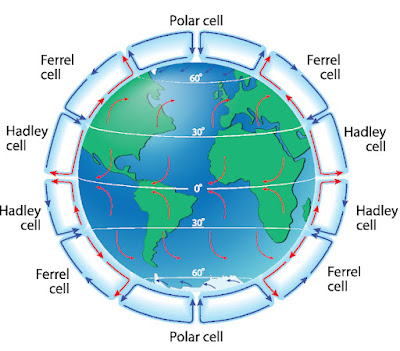I’ll admit that the term “boundary conditions” used to make me twitch. Partial differential equations and 4-dimensional (three physical dimensions plus time) calculus were always difficult hurdles for me (and not a small part of the reason why I moved from physics over to geology!) But differential equations—diffEQ’s, as they’re known in the biz—are the real mathematic sorcery within climate, or almost any natural system model. In the end, you plug numbers into the many different variables and receive numerical output. You can look at all math as just increasingly fancy types of addition and subtraction. But what makes an equation “differential” is that it focuses on differences.
This is because a “differential” in mathematics is computed from a rate of change. How much does one variable (y, for example) change when another (x) changes? This rate of change itself can vary: an increase in (x) of 1 might under different circumstances produce different changes in (y). Look at the sine wave, a smoothly varying curve, in the illustration. With each identical forward step in the horizontal axis (x), the height (y) changes by a slightly different amount from the previous, and following, amounts. That’s what creates the curve, as opposed to a straight line. In a curve, the rate of change—the slope of the graph—changes as you move along it. That’s bad enough. How about more variables? What if (y) depends not only on (x), but also on (z), (a) and (b)? Hence the sorcery!
In nature, where just about nothing is constant (though we often pretend they are, to simplify the math), rates of change are the simplest means to approach almost any topic. Predicting the water level and current velocity of tides—extremely important for shipping—are an ideal application of diffEQ’s. Disease control, where microbes grow exponentially—with increasing speed as their population grows, until the system becomes full—is another. For a climate example, the temperature of ocean water will vary in space—east (x), north (y), depth (z), and in time (t). Those four fundamental variables determine quite a lot, but not everything!
A more complex species of diffEQ’s contains these built-in boundaries,
so the system and its variables don’t become unrealistic. This is because
climate models are relentlessly tuned to known, measured aspects of global climate.
In climate models, most boundary conditions are empirical: that is, based on measurements, not theoretical
derivations. Topography (mountains, valleys, plains.) and bathymetry
(coastlines, channels and basins) are two obvious, measured boundary
conditions. Other empirical boundary conditions include the amount of solar
energy entering earth’s climate system (not constant! Because earth is in
motion, and its orbit is elliptical), changing land use patterns (a very
important aspect), and many more. These models are complicated.
Tomorrow: some of the main boundary conditions used in IPCC
climate models.
Be brave, be steadfast, and be well.





















































